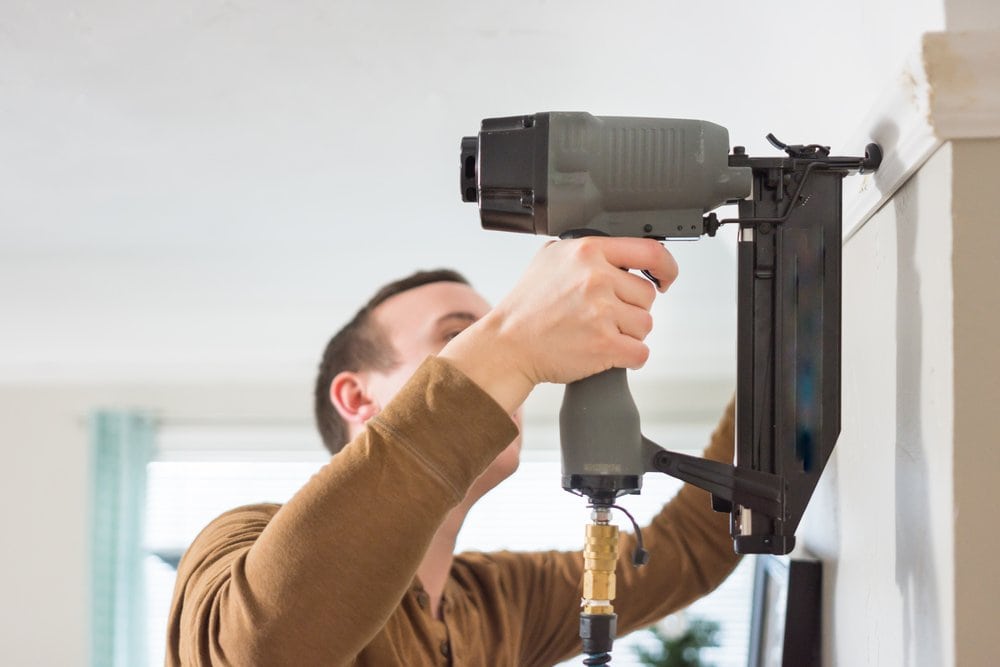When you’re working on a project, finishing it with nails is the final step towards success. But nailing it in can be so monotonous, and there is room for error. Shaky hands? Expect for your hands to be hit a few times. And even if you’re precise, the finish just doesn’t look straight.
As humans, we are limited. We don’t have four hands that can hit the nails with precision. But what we lack in hands, we have in brains, and that’s why the trim nail gun was invented. In this post, let’s take a look at it, what it does, and some tips.
What is a trim nailer gun?
A trim nail gun, powered by pneumatics, can install multiple nails in a quick succession, which is important when you need a job that requires you to install plenty of nails.
A trim nailer involves putting the nails in areas that are visible and may require delicate movement. They come in different gauge sizes and come in different names. For instance, there is the 15 or 16 gauge, which is the biggest, and these are called finish nailers. 18 gauges are the mid-sized ones and go by brad nailers. Finally, we have the 23 gauge, which is the smallest and goes by the name of pinner.
What are the best nails to use?
For a trim nailer, the best types of nails you should use tend to be brad nailers. These are thinner nails, which will create a tinier hole that’s easy to smooth out. That is what makes them great for any finishing purpose.
As mentioned before, the more gauges in a nail gun, the smaller nails they will shoot. What size brad nail you need can depend on how thick the materials are. One rule of thumb is to take the material’s thickness and multiply it by three. For materials that have 20mm of thickness, you may need a 60mm, and so on.
Nails can take a bit of experimentation to find out which one is right for the job.
Common Problem #1: Air Leaks
Being a pneumatic tool, there’s a chance air leaks can happen, which can make the nailer underpowered. It can happen due to aging or because the parts are not in their right place.
First, you may want to give it a hit with a rubber mallet. Fire the nailer while there are no nails in it, and hit it. This can fix the leak. If not, you may need to replace its O-ring, which is a cheap fix. For leaks in the back, reset its seals.
Finally, if it’s still leaking, you may need to take it apart to find the culprit. For trigger leaks, you will probably not be able to buy the valve and you may need a new trigger altogether.
If you’re still having issues, there is a point where buying a new one may be the better option.
Common Problem #2: The Guide Isn’t Working
The guide is what moves the nail in a forward direction. If it’s not working, it can be troublesome to use the nail gun. The most common reason why this may happen is due to the lack of cleaning. Dirt, grease, and grime can interfere, and a simple cleaning can fix it.
If not, it may be due to its loader spring, magazine, or guide itself being bent or broken. These may bend or because of improper use or with time. You may need to replace the parts.
Common Problem #3: Firing Too Many Nails
Your nail gun is feeling more like a nail AK-47, firing two nails at once, so how can you fix that? It may be due to a lack of pressure, a trigger valve that is leaking, or the contact firing mechanism having problems. The first common problem can be the answer to the first two problems. As for the contact firing issue, you may need to replace the spring in the nail gun’s nose.
Can you install trim without a nail gun?
Yes, you can. In order to do so, you’re going to need nails and a hammer. Basically, you do it the old fashioned way.
While you can, there are many reasons why you may want to go with the nailer. For one thing, trim nailers are fairly cheap. You can find them for about $30 or so. Another reason why you may want to go with the nailer is that it’s time-consuming. Having to hammer in each nail by hand is quite annoying. Finally, it’s much easier to mess up your finish when you do it by hand. You may end up bending the board or installing the nails improperly. So yes, you can do it, but you’re better off getting a nail gun.
Electric or Cordless?
Nail guns can be powered by a cord, which will usually connect to an air compressor or an outlet, or they can be cordless. Cordless trim nailers use a battery that you can recharge.
Cordless nailers are more expensive, usually going for triple the price or even more. However, if you have jobs where cords are a challenge, consider the cordless.
Back in the day, a cordless nailer was underpowered and didn’t last long, but nowadays, you can find nailers that are cordless and can last a good while, all while delivering the finish you expect.
In Conclusion
Trim nailers can get the job done, and we highly recommend you purchase one if you want to get your finish completed in the quickest and most efficient manner. They’re cheap, easy to use, and you can do a lot out of them. Give them a go and see if they’re for you.

